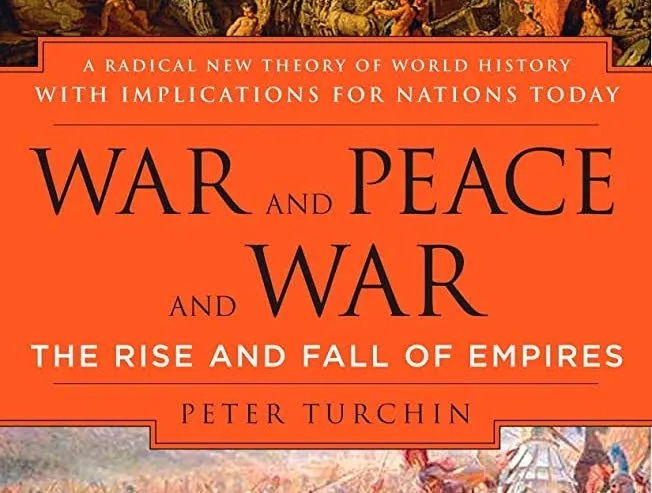![]()
In the Margins: Life on the Metaethnic Frontier
Footnotes on the rise and fall of empires
The rise and fall of empires provide an important background for ponerology. Pathocracies often grow within the corpse of the dying empire on which they inflict the final blow. Within the waxing and waning of the largest political and geographical units on our planet are smaller, secular cycles. Lobaczewski refers to the latter psychologically, as “hysteroidal” cycles.
As I pointed out in the footnotes to Political Ponerology, Peter Turchin has probably done the most to make the study of secular cycles a scientific endeavor (he has named it cliodynamics). When I start a book of his, I devour it. (Thankfully he’s got a new one coming out soon: End Times: Elites, Counter-Elites, and the Path of Political Disintegration.) Here I will summarize some of the points from his 2006 book War and Peace and War: The Rise and Fall of Empires.
The book is divided into three sections: imperiogenesis (on the birth of empires), imperiopathosis (on their decline and death), and cliodynamics.
First some definitions.
An empire is a large, multiethnic territorial state with a complex power structure. (p. 3)
While we no longer have emperors, we still have empires, according to this definition. The United States, China, and Russia are all modern empires (Russia having reentered the fray in the years since Turchin wrote this book). The EU is almost but not quite an empire.
Ethnicity is the group use of any aspect of culture to create internal cohesion and differentiation from other groups.
The broadest groupings of people that unite many nations are usually called civilizations, but I prefer to call such entities metaethnic communities …
Historical dynamics can be understood as a result of competition and conflict between groups, some of which dominate others. Domination, however, is made possible only because groups are integrated at the micro level by cooperation among their members. (p. 5)
This group cohesion is called asabiya, following Ibn Khaldun.
Turchin argues that only groups with high levels of asabiya form large empires, and such empires always form on metaethnic frontiers, the boundaries between two different metaethnic communities. Empires do not form “where political boundaries separate culturally similar peoples” (p. 6). This process is facilitated by symbolic markers (which delineate metaethnic groups) and the “moralist strategy” (the tendency to punish those who do not cooperate). Life on the frontier is where equality is highest, conflict and threat is the most intense, and asabiya strongest.
The disintegrative phase of empires is characterized by such things as: decline in asabiya, overpopulation, lower wages, higher rents, greatly increased wealth disparities, declining standards of life (first for commoners, then for elites themselves), elite overproduction, intra-elite competition, civil war, and popular rebellions. The center no longer holds, and the collapse brings famine, war, pestilence, and death. The cycle beings anew.
A life cycle of a typical imperial nation extends over the course of two, three, or even four secular cycles. Every time the empire enters a disintegrative secular phase, the asabiya of its core nation is significantly degraded. (p. 9)
The characteristic time scales, therefore, are a millennium for the asabiya cycle, 2 to 3 centuries for a secular cycle, and 40 to 60 years (two generations) for fathers-and-sons cycles [of political instability and civil warfare, separated by periods of fragile peace]. (p. 286)
When the core rots, new nations arise on the periphery, where conflict can still generate asabiya, and the new nations can feed on the once great empire’s remains.
The Metaethnic Frontier
Here are some of the examples Turchin brings to bear on his subject:
- The massive inner Asian frontier saw the birth of the great Chinese and steppe (the Hsiung-Nu, Turks, and Mongols) empires.
- The Roman empire was consolidated on the lengthy metaethnic frontier with the Celts (as was the Macedonian, first against the Thracians). Rome itself began as a frontier town.
- All subsequent large European states formed on the Roman frontier (the Franks, the Ostrogoths, the Avars, the Bulgars, Hungary, and the Byzantine Empire). By contrast: “None of the nonfrontier regions of the Roman Empire—Italy, Greece, Spain, and southern Gaul—showed any signs of incipient empire formation” (p. 87). None of the northern European groups farther away from the frontier did either.
- The Franks were in a pressure cooker of Muslim Saracens, pagan Vikings, Slavs, and Magyars.
- The whole Byzantine empire was a frontier—hammered on all sides by the Persians, Arabs, Huns, Avars, Slavs, and Bulgars.
- The Arabs faced three frontiers: Roman-Byzantine, Parthian-Persian, and Ethiopian Axum.
- The Fatimid caliphate also formed on the MENA Roman frontier.
- Lithuania was caught between the Germans and the Golden Horde.
- The Russian empire formed on the metaethnic frontier with the Tatars. The early Muscovites hadn’t the asabiya to unite against the Mongols in earlier centuries, whose own asabiya was legendary.
- The American empire was forged on the metaethnic frontier with the American Indians.
By contrast, there had been no sub-Saharan African empire prior to Western colonization. The various African groups lacked a metaethnic frontier, and thus developed no wider sense of shared identity.
The Horsemen
Commenting on the fairly standard “fathers-and-sons” mini-cycles during the Hundred Years of Hostility in France, and the alternation of good and bad reigns, Turchin writes:
In the beginning of the conflict, each act of violence triggers chains of revenge and counter-revenge. With time, participants lose all restraint, atrocities become common, and conflict escalates in an accelerating, explosive fashion. After the initial explosion, however, violence drags on and on, for years and sometimes even for decades. Sooner or later most people begin to yearn for the return of stability and an end to fighting. The most psychopathic and violent leaders get killed off or lose their supporters. Violence, like an epidemic or a forest fire, “burns out.” … Those people … who directly experienced the period of civil warfare, become “immunized” against it, and while they are in charge, they keep things stable. (p. 243)
Interestingly, catastrophic epidemics “always strike during the same phase of the secular cycle—at, or just past, the population peak” (p. 213). Turchin chalks this up to increased mobility, overcrowding, and malnourishment. People are more vulnerable, and more likely to spread disease.
These (and other mass casualty events) have the ambivalent effect of causing massive destruction, but also leveling the playing field. Inequality goes down as wages increase, rents decline, peasants acquire more land, and the number of elites plummets (as do their fortunes). (Walter Scheidel called such violent events “the great leveler”—the only historical means of eliminating massive inequality.)
On social and economic inequality, which increase during disintegrative phases to absurd proportions, Turchin writes: “This aspect is of particular interest because of the corrosive effect that glaring inequality has on the willingness of people to cooperate, which in turn underlies the capacity of societies for collective action” (p. 261). Inheritance laws—along with the other factors mentioned above—tended to concentrate wealth over time to the point that a tiny minority owned pretty much everything. Inequality always exists, but in good times of relative equality, in Medieval England, for instance, such disparities were “accepted … as ordained by God” (p. 269).
Sovereigns had some innovative ways of implementing sorts of “progressive taxes” on the fiscally engorged nobles, like imposed state visits to their castles, the costs of which made a fair dent on the nobles’ hospitality and checkbooks. Elizabeth I thought of that one, inviting herself and her whole court to be entertained at the nobles’ expense. Henry VII and VIII just murdered the richest landowners (potential rivals to the throne). Augustus forced the richest nobles to include him in their wills.
The Myth of Self-Interest
Turchin summarizes the research on cooperation in the chapter of this name. Kin selection may help us understand nepotism, and reciprocal altruism helps explain cooperation in groups, but not past a certain size; neither explains the type of large-scale cooperation seen in large states and empires. Experiments show a basic psychological truth about the variation of human types: the rough division into “knaves” (the self-interested, “rational” agents who are willing to free ride and take for themselves at others’ expense), the “saints” (who contribute to the common good even when they lose out in the process), and the “moralists” (40-60%, those who punish cheaters, even if it costs them—second-order moralists punish those who don’t punish knaves). Different societies have different proportions, and cultural practices facilitate cooperation.
The experiments also point to the key role of the moralists. Kindly saints are completely ineffectual in preventing cooperation from unraveling. In the absence of effective sanctions against free-riders, opportunistic knaves waste any contributions by the saints to the common good. (p. 122)
The behavior of moralists doesn’t influence everything however; prices are still ruled by supply and demand, for example. But they are essential for the forging of high group asabiya, and keeping it.
The Duelists
My “In the Margins” posts are supposed to be extended footnotes to Ponerology, a way of making connections between the book and other authors saying similar things in different ways. But so far I’ve just been summarizing interesting parts. So here we go. When discussing peaks of social hysteria (which presage crisis periods at the end of secular cycles), Lobaczewski wrote this:
Grey-haired Europeans living in the U.S. today [in the 1980s] are struck by the similarity between these phenomena and the ones dominating Europe at the times of their youth. The emotionalism dominating individual, collective, and political life, as well as the subconscious selection and substitution of data in reasoning, make communication difficult. … The mania for taking offense at the drop of a hat provokes constant retaliation, taking advantage of hyper-irritability and hypo-criticality on the part of others. This can be considered analogous to the European dueling mania of those times. (PP, p. 64)
This hysteria is an upper-class problem:
A greater resistance to hystericization characterizes those social groups which earn their daily bread by daily effort, and where the practicalities of everyday life force the mind to think soberly and reflect on generalities. As an example: peasants continue to view the hysterical customs of the well-to-do classes through their own earthy perception of psychological reality and their sense of humor. (PP, p. 172)
Now here’s Turchin on intra-elite competition in late sixteenth century England, at the tail-end of that cycle:
… a veritable epidemic of dueling swept the English aristocracy. … This might not represent the most accurate method for tracing social trends, but the eightfold increase in duel incidence, occurring over the span of one generation, speaks for itself. (p. 275)
And in France during the time of Richelieu and d’Artagnan:
We do not know whether the real d’Artagnan fought as many duels as the fictional one, but he probably fought his share, because France of his time was at the crest of the wave of a dueling epidemic. Dueling had almost disappeared in France during the fifteenth and early sixteenth centuries. … One estimate was that 7,000 to 8,000 were killed in the two decades after 1588. … Violence was rampant not only between individual nobles, but also between noble factions. (pp. 276-277)
Of course, this creates the conditions for civil war and revolution. Elite overproduction means smaller fortunes for the nobles, and they may turn to force to attempt to get back what they feel they are entitled to by birth. But not everyone behaves that way—just the “knaves.” There’s another motivation. When the moralists among the elite see some families dominating and monopolizing state resources, their sense of fairness and proportionality is assaulted.
The moralistic impulse is to punish the offender. … When presented with glaring injustice, moralists also self-organize in action groups. Such faction formation is the usual stage before the full-blown revolution. … Rampant inequality feeds into the perception of the extant social order as unjust and illegitimate, and creates excellent breeding conditions for the rise of revolutionary ideologies. (p. 278)
Or, as Lobaczewski put it:
Revolutionary and radical ideas find fertile soil among such people in downward socio-occupational adjustments [e.g. surplus elites]. (PP, p. 43)
To individuals with various psychological deviations, such a social structure dominated by normal people and their conceptual world appears to be a “system of force and oppression.” … If, at the same time, a good deal of injustice does in fact exist in a given society, pathological feelings of unfairness and suggestive statements inspired by them can resonate among those who have truly been treated unfairly. Revolutionary doctrines may then be easily propagated among both groups, although each group has completely different reasons for favoring such ideas. The former see them as a means to realize their dreams; the latter unfortunately believe they will bring an improvement in their fate. (p. 127)
And here’s a special, unpublished bit from a duplicated/rewritten section of Chapter 5 included in the Polish edition, which captures some of the above dynamics, including the moralistic reaction on the part of some elites, as well as the increase in social and economic inequality:
Whenever [pathocracy] has appeared in a nation’s history, its genesis has spanned many generations. We always encounter the gradual deterioration of authoritative rule, which eventually becomes the rule of incompetent leaders. The militarism and imperialism of authoritarian governments, of people supposedly chosen by God to lead, create counterselective conditions. Abnormal individuals, especially psychopathic ones, adapt and advance more easily in such circumstances. In war they often win medals and are honored as heroes. Those who are critical and who foresee tragic consequences are pushed to the sidelines. Those who reject such governments and alliances on moral grounds, those with a normal psychological worldview, form a defiant opposition. The opposition largely consists of nations subjugated by such imperialism. Such a power must crack down on this opposition. People without remorse are needed to achieve this, which opens up avenues of advancement and privilege for them. This is how the social structure of a nation, its moral values, and its capacity for objective and critical understanding of reality gradually degenerate.
The enormous expenditure required to maintain a colossal government, police, and military apparatus, as well as upkeep of the privileged, burden the lower classes and deprive its least resourceful members of support. The indifference of the privileged and the lack of social bonds between them and the exploited plebs create division and hostility, increasing the risk of revolution. As a result, a pathological structure, in which abnormal individuals begin to play an increasing role on both sides of the barricades, develops gradually from generation to generation. This was the case in pre-revolutionary France.
Social Capital
Lobaczewski often refers to the “psychological-social structure” as categorized by special social ties or bonds. This structure gets destroyed by pathocracies, and only slowly redevelops as the decades pass. Turchin quotes the work of Robert Putnam on “social capital” (e.g. trust, norms, and networks) that facilitates large group cooperation. Turchin prefers the word asabiya for the same concept. It is the stuff that binds people into a functioning social structure. The “division and hostility” Lobaczewski describes is the loss of asabiya.
As an example, Turchin describes southern Italy (home of the Mafia), once the source of the greatest power on earth, now a region that has had abysmal social capital for centuries (probably since the collapse of the empire). There, society is extremely atomized and “all cooperative efforts are limited to the smallest possible social unit, the family” (p. 326).
Even family relations are “rife with distrust and lack of cooperation.” In short, it can’t even be called a society: “it is really a conglomerate of atomized nuclear families.” Turchin calls it an asabiya black hole. Compare to the north, which is pretty much the polar opposite—social trust is the key factor in real economic growth. (Though even then, northern Italians tend only to cooperate well in medium-sized groups. Again, they lacked a post-empire metaethnic frontier in which to re-forge that level of asabiya.)
Questions
I’ll end with Turchin’s closing remarks:
Is it possible to design institutions that will enhance asabiya…? Or, at least, can we design societies in such a way that asabiya is not constantly being degraded? Do humans always need the threat of imminent danger from some outside enemy to cooperate effectively? … Will intra-elite competition escalate into violence and cause Western states to collapse even in the presence of democratic institutions, designed to channel conflict into peaceful forms? Can we find a middle way between redistributive state socialism and letting the Matthew principle run amok, creating inequality and undermining cooperation? (p. 356)
Good questions.
If you’re relatively new to this Stack, check out my previous post on another Turchin book: Ultrasociety.

Harrison Koehli
Subscribe to Political Ponerology
Pathopolitics, psychopathy, and mass hysteria











